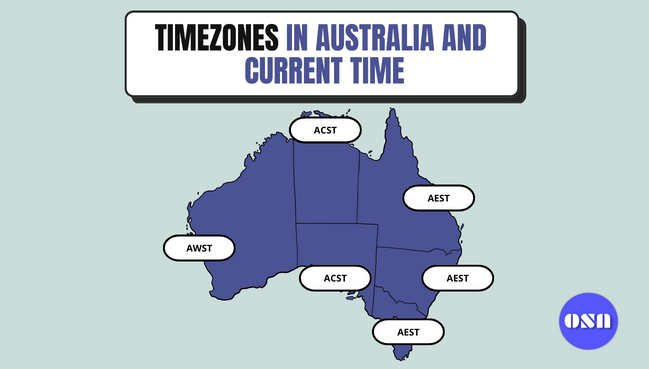Australian Time Zones and Current Time in Australia

Australia is the sixth-largest country in the world (in terms of land size) with a land mass of 7.688 million km² and an estimated population of 26 million.
So, it’s needless to say that Australia is a huge country, and thus it has multiple time zones.
But there are three main time zones in Australia, which are:
- Australian Eastern Standard Time (AEST),
- Australian Central Standard Time (ACST),
- Australian Western Standard Time (AWST).
Oftentimes migrants get confused with these various Time Zones and this results in missed flights, missed appointments and other inconvenient events.
This is why it is very important to understand the various time zones used in Australia before you migrate here.
In this blog, you will get to learn all about the time zones used in different parts of Australia and current time in Australia.
Let’s dive right in.
Australian Eastern Standard Time (AEST)
Australian Eastern Standard Time (AEST) is the most commonly used time zone in Australia.
This time zone is 10 hours ahead of Coordinated Universal Time (UTC), which is the standard time all over the world at the same time.
This particular time zone covers the following states:
- New South Wales (Except Broken Hill Town)
- Victoria
- Queensland
- Tasmania
- Australian Capital Territory
This particular time zone covers the following cities in the states above:
- Brisbane
- Sydney
- Melbourne
- Hobart
- Canberra
Australian Eastern Daylight Time (AEDT)
During Daylight Saving Time (DST), the Australian Eastern Standard Time (AEST) is moved forward by an hour, that then becomes the Australian Eastern Daylight Time (AEDT).
Daylight Saving Time (DST) is when we move our clocks forward an hour in the spring and backward an hour in the fall to make better use of the longer daylight hours during the summer.
Daylight Saving Time is put into effect at 2am on the first Sunday in October when clocks are forwarded by one hour, and it ends at 2am (which is 3am Daylight Saving Time) on the first Sunday in April when clocks are put backward by one hour.
It is important to note that not all Australian States and territories observe Daylight Savings.
If you want to know about Daylight Savings in Australia, then read our complete guide on Daylight Savings here.
Australian Central Standard Time (ACST)
The Australian Central Standard Time (ACST) is used in the central regions of Australia and is 9.5 hours ahead of the Coordinated Universal Time (UTC +9:30).
It is also 30 minutes behind the Australian Eastern Standard Time (AEST).
This particular time zone covers the following states:
- Northern Territory
- South Australia
This particular time zone covers the following cities in the states above:
- Adelaide
- Darwin
- Broken Hill
- Alice Springs
During Daylight Saving Time (DST), the Australian Central Standard Time (ACST) moves forward by an hour, this now becomes the Australian Central Daylight Time (ACDT).
As Northern Territory does not observe the Daylight Savings, only South Australia has ACDT timezone.
Australian Western Standard Time (AWST)
The Australian Western Standard Time (AWST) is the time used in Western Australia.
This particular time zone is 8 hours ahead of the Coordinated Universal Time (UTC +8:00). Unlike the other two primary time zones, AWST does not factor in Daylight Saving.
This time zone covers the city of Perth.
Asides from the 3 main time zones in Australia, there are 4 other time zones you should take note of:
Lord Howe Standard Time (LHST)
The Lord Howe Standard Time (LHST) is the time zone for the Lord Howe Island. It is Standard Time (NFT) is 10.5 hours ahead of the Coordinated Universal Time (UTC+10.30).
Lord Howe Standard Time (LHST) does observe Daylight Saving Time, but the clocks only move forward by 30 minutes, instead of an hour during summer.
Norfolk Island Standard Time (NFT)
The Norfolk Island Standard Time (NFT) is the time zone used on Norfolk Island, an external territory of Australia located in the South Pacific Ocean. Norfolk Island Standard Time (NFT) is 11 hours ahead of the Coordinated Universal Time (UTC+11).
This particular time zone covers only Kingston city and similar to AWST, it does not observe Daylight Saving Time.
Christmas Island Standard Time (CXT)
Christmas Island Standard Time (CXT) is the time zone accepted on Christmas Island, a territory of Australia located in the Indian Ocean.
Christmas Island Standard Time (CXT) is 7 hours ahead of the Coordinated Universal Time (UTC+7) and does not observe Daylight Saving Time.
Cocos (Keeling) Islands Standard Time (CCT)
Cocos (Keeling) Islands Standard Time (CCT) is the accepted time zone used on the Cocos (Keeling) Islands, an Australian territory also located in the Indian Ocean.
Cocos (Keeling) Islands Standard Time (CCT) is 6.5 hours ahead of the Coordinated Universal Time (UTC+6:30) and they do not observe Daylight Saving Time (DST).
List of all the major cities in Australia and their time zones
| City | State/Territory | Time Zone |
| Sydney | New South Wales | Australian Eastern Standard Time |
| Melbourne | Victoria | Australian Eastern Standard Time |
| Brisbane | Queensland | Australian Eastern Standard Time |
| Canberra | Australian Capital Territory | Australian Eastern Standard Time |
| Newcastle | New South Wales | Australian Eastern Standard Time |
| Gold Coast | Queensland | Australian Eastern Standard Time |
| Hobart | Tasmania | Australian Eastern Standard Time |
| Townsville | Queensland | Australian Eastern Standard Time |
| Adelaide | South Australia | Australian Central Standard Time |
| Darwin | Northern Territory | Australian Central Standard Time |
| Perth | Western Australia | Australian Western Standard Time |
Current Time in Australia
Due to different time zones, the time in Australia varies from one city to another. Here is an example of timeframes comparing to some of the popular cities around the world.
So, the example below in the table shows what time it will be in different cities if it is 5:00 pm in Sydney (Not Daylight Savings Time).
| USA (NEW YORK) | UK (LONDON) | India (DELHI) | China (BEIJING) | Japan (TOKYO) | AWST (PERTH) | ACST (ADELAIDE) | AEST (SYDNEY) |
| 12:00 am | 8:00 am | 12:30 pm | 3:00 pm | 4:00 pm | 2:00 pm | 3:30 pm | 5:00 pm |
Current Time in Australia’s Capital City, Canberra:
To know the current time in Australia according to their respective regions, states and time zones click here
With this knowledge of Australian time zones, you can properly prepare for appointments, meetings, and travel throughout the country.
If you liked this article, you might also like to read our article on Seasons in Australia.









